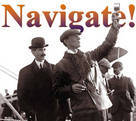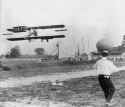|

 Up
Up 
 The Patent
The Patent
Wars 
(You are here.)



  Need
to Need
to
find your
bearings?
Try
these
navigation aids:
If
this is your first
visit, please stop by:
Something
to share?
Please:



|
|
Available in Française, Español, Português, Deutsch, Россию,
中文,
日本, and others.
 lthough
Bleriot's flight across the English Channel was the biggest news of the
day, it wasn't the news that concerned the Wrights the most. On June 26,
Glenn Curtiss of the newly incorporated Herring-Curtiss Company, sold an
airplane to the Aeronautical Society of New York — the first private
airplane sold in the United States. lthough
Bleriot's flight across the English Channel was the biggest news of the
day, it wasn't the news that concerned the Wrights the most. On June 26,
Glenn Curtiss of the newly incorporated Herring-Curtiss Company, sold an
airplane to the Aeronautical Society of New York — the first private
airplane sold in the United States.
After the success of the June Bug, the members of Alexander
Graham Bell's Aerial Experiment Association designed and built its final
airplane, the Silver Dart. It was the first American aircraft built
by a team other than the Wright brothers that performed well enough to be
considered a practical aircraft.
Thus encouraged, the AEA considered forming a company to manufacture
and sell airplanes. Bell told the members (erroneously, it turned out)
that they had not trespassed on the Wright patent. They had, in fact,
generated a few patentable ideas of their own. In the midst of these
discussions, Curtiss received a telegram from Augustus Herring suggesting
that the two form a partnership to build airplanes.
Herring had not returned to Fort Meyer in 1909 to compete with the
Wrights for the Army contract. Instead, he chose to continue his farce by
announcing that he had passed over the Army business for a more lucrative
arrangement with a mysterious "foreign syndicate." He told
Curtiss that he had patents that pre-dated the Wrights. Curtiss decided to
take Herring up on his offer because he assumed that Herrings patents
would protect him against a law suit from the Wrights. He never supposed
that the patents were another one of Herring's fictions. Curtiss took his
leave of the AEA without telling them what he was up to — they would
read about it in the papers.
Curtiss unveiled the Aeronautical Society machine, which he called the Golden
Flyer, on June 16, flying it from Morris Park in the Bronx. (The press
mistakenly dubbed the aircraft the Gold Bug, mixing up its name
with the now famous June Bug.) To put a
little extra distance between his airplane designs and the Wrights, he
mounted ailerons between the wings of the biplane. He began to make
exhibition flights and train students. On July 17, he flew the Golden
Flyer for 25 miles and captured the Scientific American Trophy for the
second year in a row.
This stretched the Wright's patience to the breaking point. Wilbur
filed a patent-infringement suit against Curtiss on August 16 and another
on August 19 seeking to prevent the Aeronautical Society from flying the Golden
Flyer. It was the first shot in what would become known as the
"Patent Wars."
|

A close up of the Silver Dart.

The Silver Dart lifts off a frozen lake in Nova Scotia -- it was
the first airplane to fly in Canada.

A crowd gathers around the newly-delivered Golden Flyer at Morris Park
(later, Aviation Field) in the Bronx, New York.

The cockpit of the Gold Bug.

The engine of the Golden Flyer. Later, this was replaced with a better,
more powerful engine.

Curtiss test-flying the Golden Flyer. |